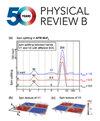在宽结合能范围内对所有分子轨道进行断层识别
IF 3.7
2区 物理与天体物理
Q1 Physics and Astronomy
引用次数: 0
摘要
在过去的十年中,光电发射轨道层析成像(POT)已经发展成为研究表面吸附有机分子电子结构的有力工具。在这里,我们证明了POT允许在大于10 eV的大量结合能范围内对所有分子轨道进行全面的实验鉴定。利用光电子的角分布作为结合能的函数,我们从Cu(110)表面上典型有机分子二蒽(C28H14)的实验数据中提取了15 π和23 σ轨道的轨道分辨投影态密度。在给定的结合能范围内,这些基本完整的轨道集的实验结果作为电子结构方法的严格基准,我们通过使用四种常用的交换相关泛函进行密度泛函计算来说明这一点。通过计算各自的分子轨道投射态密度,可以对38个轨道能量的空前数量与实验数据进行一对一的比较。数据的定量分析表明,范围分离的混合功能HSE对于所研究的有机/金属界面表现最佳。在一个更基本的层面上,在大于10 eV的结合能范围内,实验和Kohn-Sham轨道能量之间的显著一致性表明——也许出乎意料——Kohn-Sham轨道近似戴森轨道,戴森轨道将严格解释光电光谱中的电子提取过程,但众所周知难以计算,比以前想象的要好得多。2025年由美国物理学会出版本文章由计算机程序翻译,如有差异,请以英文原文为准。
Tomographic identification of all molecular orbitals in a wide binding-energy range
In the past decade, photoemission orbital tomography (POT) has evolved into a powerful tool to investigate the electronic structure of organic molecules adsorbed on surfaces. Here we show that POT allows for the comprehensive experimental identification of all molecular orbitals in a substantial binding energy range of more than 10 eV. Making use of the angular distribution of photoelectrons as a function of binding-energy, we exemplify this by extracting an orbital-resolved projected density of states for 15 π and 23 σ C 28 H 14 Published by the American Physical Society 2025
求助全文
通过发布文献求助,成功后即可免费获取论文全文。
去求助
来源期刊

Physical Review B
物理-物理:凝聚态物理
CiteScore
6.70
自引率
32.40%
发文量
0
审稿时长
3.0 months
期刊介绍:
Physical Review B (PRB) is the world’s largest dedicated physics journal, publishing approximately 100 new, high-quality papers each week. The most highly cited journal in condensed matter physics, PRB provides outstanding depth and breadth of coverage, combined with unrivaled context and background for ongoing research by scientists worldwide.
PRB covers the full range of condensed matter, materials physics, and related subfields, including:
-Structure and phase transitions
-Ferroelectrics and multiferroics
-Disordered systems and alloys
-Magnetism
-Superconductivity
-Electronic structure, photonics, and metamaterials
-Semiconductors and mesoscopic systems
-Surfaces, nanoscience, and two-dimensional materials
-Topological states of matter
 求助内容:
求助内容: 应助结果提醒方式:
应助结果提醒方式:


